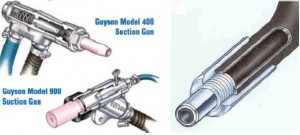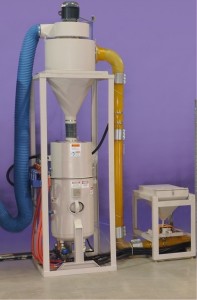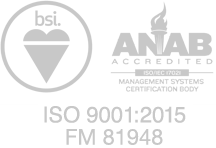One of the questions most frequently asked of Guyson’s applications team is about the differences between suction-blast and pressure-blast equipment. A brief explanation may be helpful if you are unsure about the pros and cons of these two types of media delivery systems.
 To start with basics, a suction-blast gun (sometimes called a siphon or vacuum induction gun) has two hoses, one for air, one for media. When you activate the gun, compressed air is metered into the gun body by an air jet and projected out of the blast nozzle, a powerful vacuum is
To start with basics, a suction-blast gun (sometimes called a siphon or vacuum induction gun) has two hoses, one for air, one for media. When you activate the gun, compressed air is metered into the gun body by an air jet and projected out of the blast nozzle, a powerful vacuum is
generated that pulls media up into the gun. Mixing into the air stream and acceleration of the media particles takes place in the body of the suction-blast gun and in the blast nozzle.
A pressure-blast nozzle has one thick-walled hose that is attached to a metering valve at the base of a pressurized tank or pot. When you start blasting, media is forced into the air stream at the pressure pot and accelerated throughout the length of the blast hose and the nozzle.
Greater Media Velocity
For any given blast pressure, the extended acceleration path of media in the pressure-blast system yields higher blast particle velocities. The greater intensity of pressure blasting makes it the preferred method for applications that require more forceful media delivery, including the following:
- Removal of tough mill scale or surface deposits
- Stripping of hard or thick coatings
- Shot peening to higher intensities
Faster Coverage
 The blast pattern of most pressure-blast nozzles is significantly larger than the area covered by a suction-blast gun. This enables work pieces with a lot of surface area to be finished more rapidly with pressure-blast media delivery – in manual blasting jobs, 3 to 4 times faster than suction-blast.
The blast pattern of most pressure-blast nozzles is significantly larger than the area covered by a suction-blast gun. This enables work pieces with a lot of surface area to be finished more rapidly with pressure-blast media delivery – in manual blasting jobs, 3 to 4 times faster than suction-blast.
By the same token, whenever the blast cycle time for processing a component needs to be reduced, pressure-blast can be expected to help accomplish the work more quickly.
Higher Costs for Pressure-Blast
 As you might expect, the extra hardware involved in an industrial pressure-blast system translates to a higher price tag than suction-blast. It does not stop at the initial equipment investment. Since the media delivery system parts are constantly in contact with shot or grit media, you can anticipate additional expense, compared to maintenance of a suction-blast machine, for replacement of worn pressure-blast machine components.
As you might expect, the extra hardware involved in an industrial pressure-blast system translates to a higher price tag than suction-blast. It does not stop at the initial equipment investment. Since the media delivery system parts are constantly in contact with shot or grit media, you can anticipate additional expense, compared to maintenance of a suction-blast machine, for replacement of worn pressure-blast machine components.
There is another point to be made about maintenance of pressure-blast systems. The more aggressive nature of pressure media delivery, especially when fast-cutting grit is being used, results in increased wear-and-tear on machine components that happen to be in the line-of-fire of the pressure-blast nozzles. Parts like protective rubber curtains, shields around spindles, anti-frost protection for cabinet windows and ordinary rubber flaps at the entry and exit of the blast cabinet tend to suffer more wear when exposed to the greater intensity of pressure blasting. You can expect added costs for the maintenance of worn machine parts that are not in the media delivery system.
Do You Need It?
A pressure-blast machine is not inherently superior to suction-blast, but it has capabilities that are of great value for certain types of blasting operations. When pressure-blast media delivery is required to do the work of your particular application, the costs and benefits tend to fall into place in your justification.
Testing in Guyson’s applications engineering lab is available to demonstrate the effectiveness of pressure-blasting for your specific purposes and get recommendations about an upgrade of your blast process.
Contact Guyson if you would like to arrange an on-site consultation with a factory applications specialist or to ask a question.



